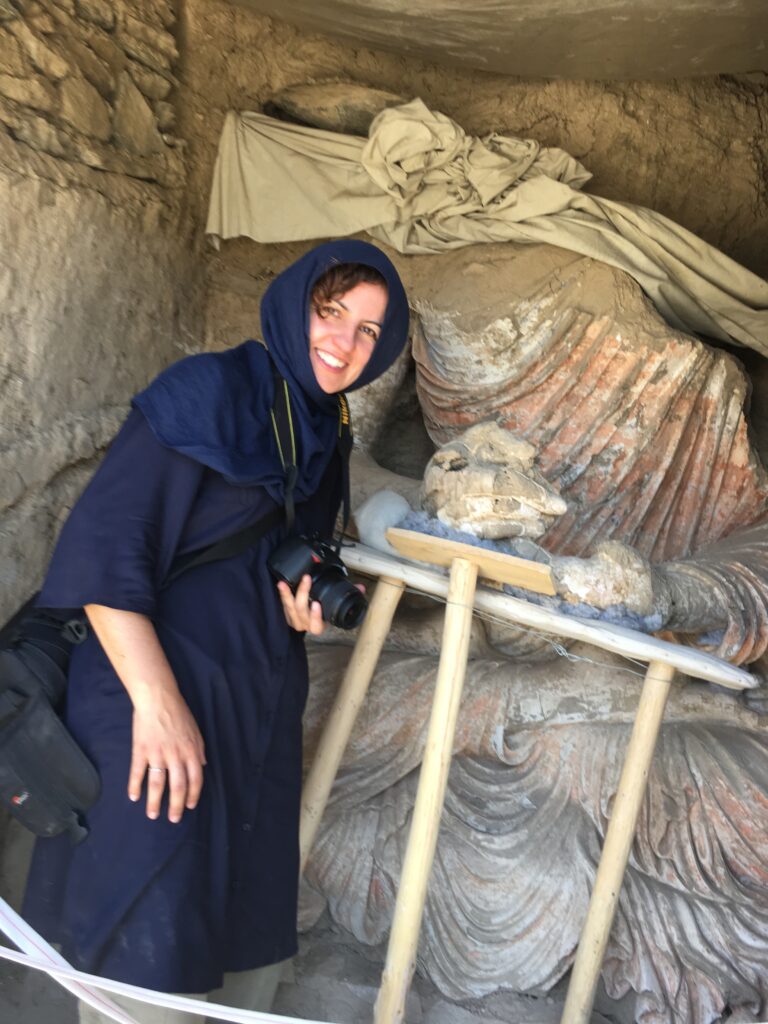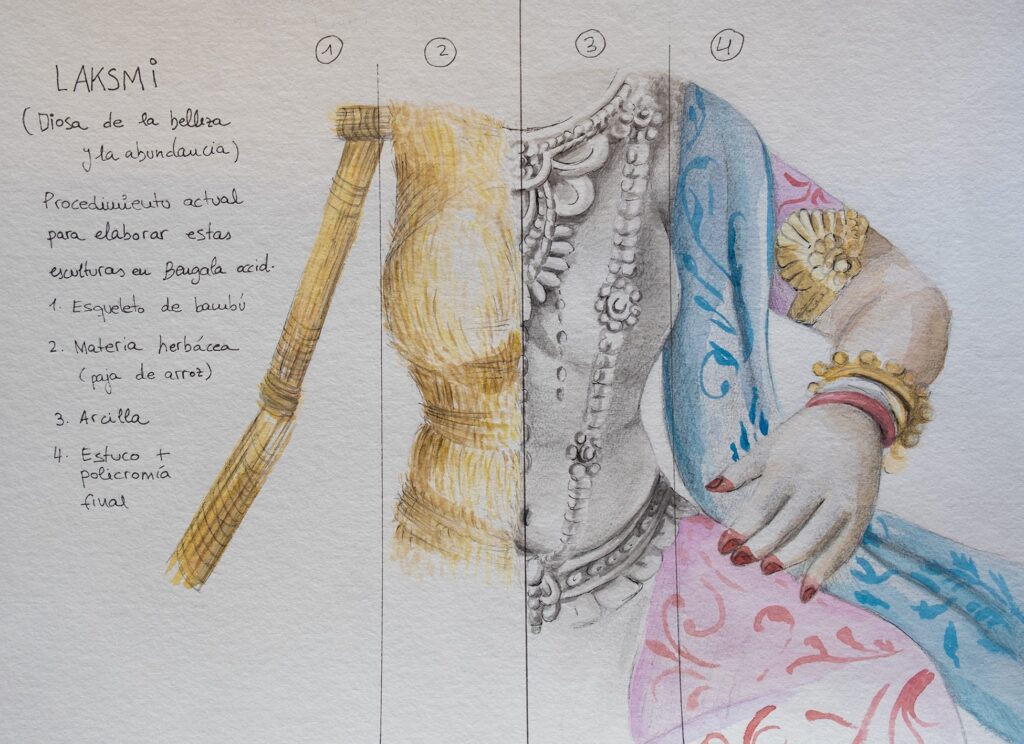In the vast tapestry of human history, archaeological conservation plays a crucial role in the preservation of our cultural heritage. A fascinating example can be found in the Silk Roads, those ancient trade routes that not only connected East and West, but also facilitated a cultural and artistic exchange that still resonates today. Through the meticulous preservation of these historical relics, we can not only better understand our past, but also ensure that future generations can learn and benefit from this invaluable legacy. Preserving these archaeological treasures allows us to keep alive the connection to our roots, while providing a bridge to a more informed and conscious future.
I tell you about this through a fascinating example you may not have heard of before: monumental sculpture in terracruda (NOT terracotta), a type of sacred art unique to the Silk Roads, practised from the 2nd century BC to the present day. For this, I have the help of a specialist in the subject, Mònica López-Prat Ph.D (here is a link to her LinkedIn for more information).
We will talk about how a multidisciplinary study can, on the one hand, better conserve this type of fragile works, and on the other, enhance the value of all the material and symbolic knowledge they conceal. We will comment on how this has in turn allowed us to reformulate many of the art-historical theories that were held until now about their origin and dissemination.
Will you join us?
The watercolour drawings in this article are based on photographs provided to me by Mònica.

MONUMENTAL CLAY-BASED SCULPTURES
Let’s start at the beginning, what they are, what they look like, and where these sculptures are. Mònica tells us about them:
What are they?
These are large sculptures made of unfired clay. Clay has traditionally been a preferred material for representing divinity. Thanks to its ubiquity and versatile properties, it has been used by humans since prehistoric times for artistic manifestations. While different religions and myths describe its use for such purposes, it is in Central Asia, in the heart of what are now known as the «Silk Roads», that more than 2,000 years ago «terracruda» (understood as air-dried clay sculpture in contrast to fired clay or terracotta sculpture) acquired its most sacred significance, giving rise to the art of modelling divinity in monumental form. These sculptures can be smaller than human size or reach several metres in height.
The first examples of this artistic tradition appear in Central Asia between approximately the 2nd and 1st centuries BC through the convergence of Indian, Persian and Hellenistic cultural influences, becoming one of the most significant manifestations of the transfer of knowledge along the Silk Roads, spreading successively with Buddhism to East Asia and the Himalayas, where examples are still venerated to this day.
What are they like?
These sculptures, beyond corresponding to different regional artistic currents, follow a common pattern of elaboration transmitted through the Silk Roads over the centuries; a technique that spread and was adopted, hand in hand with Buddhism, in many of the regions that adopted this spiritual tradition, adapting itself to the different artistic currents.

Although clay can be considered the basic material for modelling, sculptures are ‘multi-material’. They are usually constructed from a wooden skeleton or a brick/stone core, to which are superimposed multiple layers of clay or mud prepared differently depending on whether they are the inner or outer layers, with the herbaceous/fibrous material playing the essential role of adding volume, lightening the weight and facilitating the drying of the sculptures.
If we were to propose a technological definition, monumental clay-based sculptures are characterised by the following essential elements:
- Construction of a core or base structure (usually wood, brick or stone) anchored to the wall and/or floor or forming part of it (in the case of brick and stone).
- Superimposition of branches, herbaceous material, and/or ropes on the base structure when it is made of wood, giving volume to the initial skeleton.
- Addition of various clay-based layers ranging from thick to more refined depending on their composition.
- Application of modelled or stamped details using moulds.
- Finishing layer (called ‘stucco’ when it is white).
- Polychromy and/or gilding.
The result is versatile, heavy and fragile sculptures, with great detail, which can be larger than human size.
Where are they?
Although Buddhist art played a key role in the spread of monumental clay-based sculptures, especially from the 3rd century AD onwards, the earliest examples of this artistic tradition date back to the 2rd-1st centuries BC, when Buddhism was not yet the dominant spiritual current in Central Asia and this region was under the Hellenistic influence of the so-called Greco-Bactrian kingdoms. These early examples were mainly found as part of sacred buildings.
Particularly important are those found at the archaeological sites of Ai-Khanum (2nd century BC, northeastern present-day Afghanistan) and Old-Nisa (2nd-1st century BC, southern present-day Turkmenistan). We could also include some of the ‘unfired clay portraits’ found at the Bactrian sites of Takht-i-Sangin (present-day southern Tajikistan, 3rd-1st century BC), the ‘monumental painted clay sculpture’ of Khaltchayan (1st century BC-1st century AD, South Uzbekistan), the «polychrome clay high reliefs from Elkharas» (III – II BC. ) found in ancient Khorasmia (present-day northwestern Uzbekistan) and the ‘sculptural high reliefs modelled in unfired clay’ from the Achaemenid sites of Akchakhan-kala and Toprak-kala – two royal seats and ceremonial centres located within 15 km of each other in present-day Karakalpakistan dated between the 1st century BC and the 2nd century AD.

Sculptural manifestations are the product of a knowledge that, through the ‘Silk Roads’ from around the 1st century AD onwards, spread with Buddhist art to almost every corner where the Buddha’s teachings reached.
Examples of monumental clay-based sculptures are known from Central Asia and the northwest of the Indian subcontinent (present-day Pakistan and Afghanistan) to the Himalayas (Ladakh, Tibet, Bhutan), China, Mongolia and the Far East, with Japan being the country where the most eastern documented historical-archaeological examples are located.
Famous examples of these Buddhist sculptures are the great Buddha Parinirvana of Ajina Tepe (Tajikistan), the recently discovered monumental sculptures of Mes Aynak (Afghanistan), and the sculptures preserved in the caves of Mogao (Dunhuang, China) and Sumda Chun (Ladakh, India).
MONUMENTAL CLAY-BASED SCULPTURES TODAY
Mònica tells us that a similar artistic tradition exists today in West Bengal (India). Here, a group of clay sculptors, the Kumors, have preserved a long tradition related to the modelling of sacred clay sculptures for Hindu worship.
This tradition is linked to ‘The Agamas’, a collection of sacred scriptures related to the worship of God in the form of an idol and belonging to different Hindu devotional schools. Scriptures from the 8th, 12th, 16th and 16th-17th centuries AD are among the Sanskrit literature that specifically designates unfired clay, bronze, wood and stone as materials suitable for representing a divinity.

However, according to these sacred texts, among these materials only unfired clay (primarily earth and water) contains life, which makes this material «highly suitable» for the creation of cult images.
These texts detail the seven elements for constructing, which are metaphorically explained to be the same as the elements of a human body: the wooden armature (sula) represents the bones; the strings (raiju) are the veins and tendons; the different layers of clay (mrt) are the flesh and muscles; the clothing (pata) of the last layers of clay is the skin; the glue (astabandha), prepared mainly from vegetable substances by firing, is the fat; the ‘white layer’ (sarkarakalka) is the blood; and the colour (varna) is the life force.
These precepts are known and continued today by Bengali sculptors to produce the various sculptures of deities (murtis) worshipped during the Hindu tradition’s annual cycle of festivals (pujas).

CONCLUSIONS
Thanks to all this information and knowledge that Mònica has transmitted to us, we have had the opportunity to travel not only from India to the Far East, but also from the past to the present. We have seen how traditional knowledge has reached our days and how Bengali sculptors today apply precepts that derive from an artistic tradition similar to that of Antiquity.
I am particularly struck by how Hindu sacred texts speak of unfired clay as the only material that has life, and how for this reason it is the most suitable for representing divinity. The relationship between the material and the symbolic, the earthly and the spiritual, is fascinating. It is also surprising to think how monumental sculptures could be built with such a fragile material, although it was not the only one that made them. Apart from being a captivating example, it is also a pretext to talk about the importance of preserving the material remains of the past in order to better understand the technological knowledge of the societies that made them.
In short, throughout these three episodes we have seen the importance of the restoration of works and artefacts -commenting on the lesser-known world of underwater heritage restoration-, of archaeological research -detailing the day-to-day work of research groups, specifically archaeobotany-, and finally of heritage conservation with the example of monumental clay-based sculptures and its dissemination along the silk routes.
If you are interested in art and cultural heritage, don’t miss the article on Archaeology in the Indus Valley and on Restoration of works of art!!


